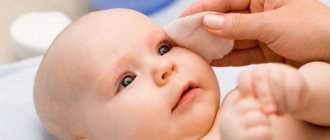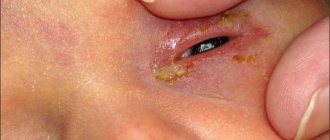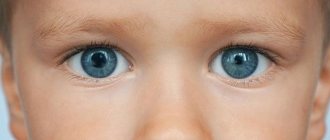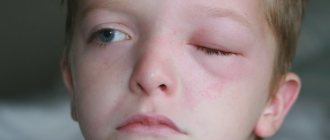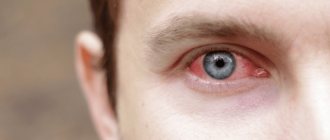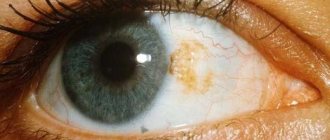At 4 months, newborns' tear ducts just open and babies begin to cry, like all adults (at an earlier age, lacrimation is not observed). It is normal for your child to be nervous, in pain, or hungry.
But there are situations when the eye waters just like that, seemingly for no apparent reason. Experts include the following as provoking factors: various infections, colds, allergies, etc. And, if the problem bothers the baby for more than 2-3 days, you need to show the baby to the doctor as soon as possible and begin treatment.
Share
Tweet
Share
Cool
Send
Why does a newborn's eye water?
Excessive tear production in children 1–2 years of age and older can be a sign of many diseases. Let's look at some of them.
Viruses and colds:
- conjunctivitis (as a consequence of ARVI or influenza);
- dacryocystitis or blepharitis;
- keratitis or scleritis;
- inflammation of the paranasal sinuses or nasal cavity.
Allergy
If a baby who has just been born has watery eyes, red eyes and sneezes, then these are manifestations of an allergy. These are negative reactions to food or to external irritants, such as animal hair, etc. In the first days of life, a child’s body may react negatively to irritants, since the immune system is still very weak.
In case of allergies, due to swelling of the mucous membrane, the outflow of tears is significantly reduced. Fluid stagnation occurs, bacteria accumulate, the white membrane of the eye turns red, and all this is accompanied by severe itching.
To get rid of allergies and alleviate the child’s condition, you need to eliminate the sources of the disease or change the formula. It is better for a nursing mother not to consume allergens, such as strawberries, apricots, etc. The specialist prescribes special antihistamines.
Foreign body
The cause of tearing in a baby may be that an eyelash, dirt, a speck of dust, or a speck has gotten into the canal. To remove any foreign body from the eye, you need:
- wash your hands first, or better yet, disinfect them with an antiseptic;
- very carefully grasp the eyelashes and pull the upper eyelid forward so that the tears themselves wash away the dirt;
- A special rinsing solution will also help;
- carefully examine the eyelid; specks most often end up there.
If you cannot remove it on your own, you should immediately consult a doctor.
Conjunctivitis
Tears can warn of the development of a disease such as conjunctivitis. In any form, the mucous membrane in children becomes inflamed, it becomes red and causes discomfort. Photophobia also appears and tears are produced. Sometimes a film or crust of pus may form on the eye. In this situation, the main thing is not to hesitate - as soon as you notice at least one symptom, immediately call your doctor.
Return to contents
Dacryocystitis
Young children often get sick, because in order for the immune system to resist infection, most of them need to be endured.
When babies have a cold, they often have dacryocystitis, which causes the eyes to fester and become watery. This happens because the infection gets to the mucous membranes of the mouth or eye, and not just into the respiratory tract. Then a defensive reaction of the body occurs, in which it seems to try to displace the virus through suppuration.
This inflammation of the tear ducts occurs in a very small percentage of babies at birth and also due to viral diseases. The doctor cleans the eye canal with dacryocystitis. According to parents' reviews, children show improvement immediately after the procedure.
Symptoms
Tearing in newborns under one year of age is not normal. The symptom doesn't just appear. Rarely does the symptom occur independently; more often it is a sign of an inflammatory process.
It is also related to age. Babies under 2 months cry without tears, this is due to the immaturity of the corresponding glands. If your one-month-old baby has excessive tearing, this is a reason to make an appointment with your pediatrician and get a referral to an ophthalmologist.
The following symptoms may accompany lacrimation:
- conjunctival irritation;
- hyperemia of the mucous membrane;
- secretion - tears or pus;
- the child becomes restless and capricious.
Diagnostics
In order to determine the disease that causes lacrimation, it is necessary to distinguish between the symptoms that appear. If a baby goes from warm to cold, for example, this can cause a defensive reaction in the form of tears. This fact is not a disease and does not require any treatment.
There are congenital abnormalities in the development of the baby’s nervous system, and this can cause tearing. If a newborn’s eyes are very watery, there are a variety of reasons:
- Lacrimal duct injuries
- Generic pathologies of the mucous membranes
- Abnormalities in the structure of the nose or simple runny nose
- Deviations in the development of lacrimal sacs
- Closing the nasolacrimal duct with embryonic films
| If your eyes are watery, you need to be examined by an ophthalmologist. The specialist immediately begins diagnosing the little patient’s eyes. |
Held:
- Examination of the external and internal eyelids, the condition of the lacrimal openings using biomicroscopy.
- A nasal and tubular sample is taken.
- Endoscopic examination of the nasal cavity.
- The lacrimal ducts are probed and washed.
- X-ray of lacrimal canals.
If there are complications, do a CT scan of the head. With its help, it is possible to identify malignant formations of the paranasal sinuses, pituitary gland, basal cell carcinoma or polyps that can provoke lacrimation.
There are also congenital pathologies of the lacrimal ducts. If signs of abnormalities are detected, it is better to correct them using surgical methods. The doctor will prescribe treatment and give certain recommendations.
Crying without tears as a means of communication between a newborn and others
The crying of a child during the newborn period can be called a kind of communication with the outside world, since he cannot yet express himself in any other way.
When the baby is not bothered by anything, and a caring mother is nearby, he behaves calmly, because he is unable to express his emotions due to the lack of a smile. If it seems to the parents of a newborn that their baby is smiling or that dissatisfaction is expressed on his face, this is explained by the usual change in the facial expressions of the child’s face. Emotions as such cannot yet be shown by a child who has not reached at least one month of age. This is due to the fact that the facial muscles in the first weeks of a small person’s life are not controlled by the subcortex of the brain, so facial expressions cannot change consciously.
Until the age of two months, a newborn's eyes are not able to distinguish colors. However, by six months the baby can easily distinguish all the primary colors - red, blue, green, yellow.
Treatment methods
Careful hygiene of mother and child is imperative. You need to wash your baby's eyes several times a day with warm chamomile infusion and use antimicrobial drops.
A massage that should be shown to parents by a specialist helps a lot. It is needed for dacryocystitis to open and clean the tear duct.
Return to contents
Treatment of conjunctivitis
After the doctor confirms the diagnosis, he will prescribe the necessary medications or procedures. It could be:
- massage of the nasolacrimal duct area;
- treatment with chloramphenicol;
- washing the eyes with furatsilin, herbal decoctions.
Traditional Treatments
To alleviate the baby’s condition, you can use drops such as “Albucid”, “Sulfacyl-sodium”, “Ophthalmoferon”. They should be applied under the lower eyelid, after cleansing the eye of pus.
Some people prefer ointments such as tetracycline. Simple furatsilin also helps well. To do this, you need to dilute one tablet in a small amount of water and wipe your eyes with this solution.
| Before starting treatment, you should definitely consult a specialist. |
Folk remedies
Herbal formulations do an excellent job of relieving the symptoms of tearing in children. These are different decoctions that need to be used to wash the eyes, ointments and lotions. Chamomile or sage helps a lot. Calendula has long been used by our ancestors to wash the eyes of babies.
Decoction recipes
- Parsley should be wrapped in cheesecloth and placed in hot water for a few minutes. After cooling the broth, you need to blot sterile gauze and apply it to the baby’s eyes for 3-5 minutes.
- Having brewed strong tea, cool it and leave for 30 minutes. The compress is applied to the eyes for half an hour.
- Fresh rose hips, jasmine and clover need to be chopped and poured with boiling water for 20–30 minutes. The cake is lightly wrung out, wrapped in gauze and applied to the eye area.
- Chop burdock and calendula leaves, wrap in cloth and dip in boiling milk. After leaving for 10–15 minutes, squeeze out the compress and apply it to the baby’s eyes.
By washing with herbal decoctions several times a day, you can avoid viral infections and inflammation. It must be remembered that the decoctions must be sterile and carefully strained from suspensions and microscopic particles.
Nursing mothers can wipe their eyes with breast milk. But this method is only suitable for newborns; for three-month-old babies it is better to use other methods.
Return to contents
Massage of the lacrimal sac of the eye
Before the procedure, you need to prepare the child. Carefully remove all pus from the eyes. To do this, you need to wipe the eyes with a well-moistened disk in liquid (so that it drips) from the outer corner to the inner one.
During massage procedures, the child should lie on his back:
- gently squeeze the liquid out of the lacrimal sac;
- drip the furatsilin solution and remove the pus with a sterile swab;
- carry out massage movements.
To do this, you need to make jerking or vibrating movements with your fingers (from top to bottom), lightly pressing on the skin. You need to start from the inner corner of the eye. The massage procedure should consist of 10 pushing movements and one vibrating in the opposite direction (from bottom to top). Sliding movements should be performed quickly enough, 2 seconds each. for every pressure.
| Massage is done 5 to 10 times a day. If the ophthalmologist, after a re-examination, determines that the canal has opened, then the massage course can be gradually stopped. |
Probing
Due to poor-quality washing during treatment procedures, traumatic damage to the canals can occur, which often leads to their narrowing, change and subsequent overgrowth. If treatment does not produce results within several weeks, then you need to contact your doctor again, who may prescribe probing.
Probing is an operation that is performed under local anesthesia and almost always ends successfully.
Treatment of blocked tear ducts
Initial treatment is conservative. The baby is given a lacrimal sac massage. Massaging forces fluid through the tubules and removes the blockage. Antibacterial agents are prescribed in the form of eye drops.
If medications and massage do not help, a probe is inserted into the nasolacrimal canal. Helps remove obstacles.
If the tear duct blockage does not resolve by 12 months, the chances of spontaneous resolution are low. It is recommended to perform a tear duct opening procedure. Balloon dilatation is performed. The risk of intervention is rupture of the lacrimal canaliculus, a complication that can be corrected.
If balloon dilatation does not help, the child will have a silicone tube inserted for a long time.
Tips for caring for the eyes of young children
In the first days of life, the baby's eyes are more vulnerable than ever. Improper care of them can provoke changes in the structure of the eye or lead to disease. Therefore, for proper washing you will need cotton pads, boiled water at room temperature, paper or gauze handkerchiefs.
- Soak a cotton swab in water and squeeze out.
- Wipe your baby's eyes from the edge of the eye to the nose.
- Taking a new disk, repeat the procedure on the other eye.
- Remove any remaining water with a napkin.
It is recommended to carry out this procedure every morning, but if there is a need for this, then several times a day, after sleep.
Signs of dacryocystitis in children
In most children, the fetal membrane in the nasolacrimal duct (or gelatinous plug) most often bursts after birth, or resolves on its own within two to three weeks without the need for any treatment. But in cases where this did not happen, as a rule, at about two months of age (and sometimes already in the maternity hospital), the first symptoms of dacryocystitis appear:
- the baby's eye waters (lacrimation);
- lacrimation;
- redness and peeling of the skin of the cheeks due to constant flowing tears;
- increased lacrimation in cold and windy conditions;
- eyelashes sticking together after sleep;
- mucopurulent discharge in the inner corners of the eyes;
- when you press on the area of the lacrimal sac, pus is released from the lacrimal punctum (the hole in the inner corner of the eye);
- The sclera (white of the eye) is usually normal in color, but can sometimes be a little red.
The first thing to do if a newborn has a watery eye is to consult a doctor for an accurate diagnosis. The sooner a specialist can identify and begin to treat dacryocystitis, the easier and faster the recovery will come.
Complications
Sometimes, with a watery eye, parents begin treatment on their own - they rinse with antiseptics or tea leaves, and instill albucid. This brings a temporary effect, but does not solve the problem. If these points are not brought to the attention of a specialist at the appropriate time, serious complications may arise:
- redness and swelling of the eyelids;
- a painful, red lump near the inner corner of the eye;
- increased body temperature;
- poor appetite, sleep disturbances and anxiety;
- fistula on the lacrimal sac;
- phlegmon (diffused purulent inflammation);
- orbital cellulitis (life-threatening inflammation of the tissues surrounding the eye).
Test Vesta
If a newborn's eyes are watery, the doctor may prescribe a Vesta test to assess the patency of the nasolacrimal duct. To do this, a special dye (collargol, fluorescein) is dropped into the baby’s eye and the speed of fluid movement through the lacrimal ducts is assessed. First, the doctor looks at how quickly the fluid leaves the eye into the nasolacrimal duct (normally no more than 5 minutes). At the same time, a cotton turunda is introduced into the nasal cavity, which should be colored after about 7 minutes by the substance entering the nose. If staining occurs later than 10 minutes, we speak of a weakly positive West test. If the turunda is not colored at all, then the test is negative and treatment must begin.
